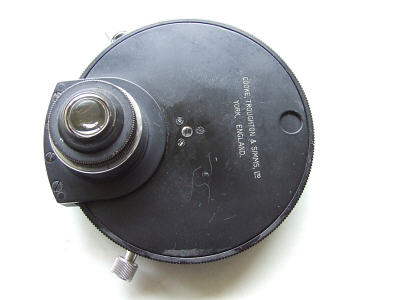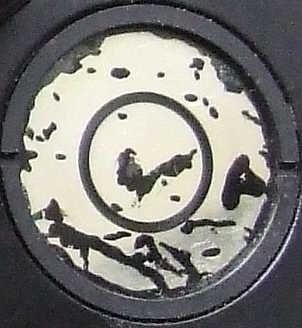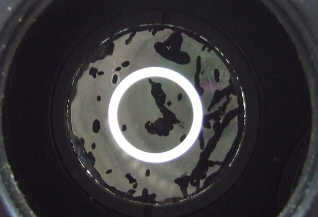 |
| Used Phase Condensers Some notes for aspiring phase contrast enthusiasts The 'nuts & bolts' (Pt 1) By Paul James |
Many amateurs have embraced phase contrast microscopy in the last few decades and it seems many more will do so in due course. I thought therefore it might be of use to compile a few notes and images in order to simplify the approach to purchasing such a device for those wishing to know a little more about the actual mechanisms of these condensers, and more especially older examples of the art. Fortunately they are not as complex as the newcomer might imagine, but some caution is however necessary to ascertain their functionality and suitability for the observer's needs.
The Basics......The mechanics of fitting a given stand
 |
Here's a rather typical British Phase Contrast condenser from the 1950's which still functions perfectly despite looking a bit old and tatty. It is based on the Zernicke principle and of having its annuli set out on a rotating disc below the condenser optic. The whole module slips into the same mounting ring used for the brightfield condenser : there are 2 fitting sizes : the English and the Continental which is slightly larger.................a situation that can cause a lot of frustration when trying to adapt a condenser to fit from one size to the other. Since each manufacturer's phase contrast condenser has been designed to fit snugly beneath the stage of their respective stands, you must never assume that they are all interchangable. Stands vary considerably beneath the stage and though your desire to get a cheap used phase condenser is understandable, its fit may match the stand's mounting ring, but frustratingly may not be capable of racking all the way up to the slide's undersurface. This applies to a lesser extent in principle to the brightfield condenser, but the phase condenser is usually larger and somewhat bulkier and often does not match the undersurface profile of the stand in question. The good news is that some do fit other maker's stands without adaptation, and some fit very well indeed!
The optical suitability for a given stand
Even if an acquired phase condenser fits your stand perfectly it must not be imagined that it will provide your phase objectives with images of the annuli that matches them, unless your objectives and condenser are from the same maker of course. Fortunately the bulk of mainstream phase contrast equipment have very similar design constraints. This means that there is often some compatability between different maker's phase contrast equipment.............but not always. So if you are keen to take advantage of an old cheapish phase condenser, you might have to adapt some of its phase annuli too. This is not a mysterious science nor even difficult to accomplish. David Walker's comprehensive article on this particular topic can be can seen here.
The fundamental requirement of the phase condenser is that it projects an image of a given annulus to a given phase contrast objective, in which there is uniformity of size or diameter.........it's as simple as that. As long as the condenser's annulus can be centered accurately in relation to the objective's annulus by adjustment of the phase contrast condenser's control screws, you will raise the phase contrast effects from the specimen you are observing.
Mechanical condition, the annuli etc..
Most of these devices will sport not only 3-4 annuli in the Zernicke disc for the phase objectives ranging from x10 to x 100, but also at least one clear aperture for brightfield use.
 |
Here's the underside view of the same condenser. You can see the 7 apertures in the rotatable disc which lies beneath a dust protective circular upper sleeve or cap. Some forms of condenser don't allow you to easily examine the innards without recourse to the use of tools, which though laudible from the point of view of longevity, does mean you cannot appraise its internal condition easily. The Brightfield apertures can be seen ( one of 3) and thus some homemade COL annuli can be installed as well, making for a very versatile condenser. The eccentric adjuster which can be manually tweaked using the control screws can temporarily seize and may need simple attention such as lubrication. Its smooth functionality is absolutely vital in centering all the individual annuli. The iris diaphragm as shown is fixed in position in this example, but some other manufacturers ( eg Zeiss) prefer it to be centerable for BF use which is unusual but decidely useful. Incidentally, if your needs are only for phase contrast, you might chance upon an example having a missing iris diapragm, or more than likely one that's defective and difficult to repair. This will reduce the value of the whole unit to your advantage!
Notice the superficially poor state of the annuli and particularly as shown below where it seems that the pitting of the 'silver metallic' deposit on both sides of the annulus ring must allow light to pour through and totally spoil the contrast enhancing effects.
 |
Closer examination reveals the curious markings or erosion effects..........possibly a mite requiring additional silver in their diet!? ....... but the good news is that the underlying paint work is sound, and thus the effectiveness of all these annuli is untainted as the whole area, despite the cosmetic condition is light proof :-
 |
The image above ( x 40 annulus ) was taken against bright daylight and but for the slightest light leakages around the outer margins of the annulus plate, which are actually well beyond the aperture limitations of all the objectives, there is nothing to be concerned about. A dab of black paint around the periphery will set the perfectionist's mind to rest. I must add that the light greyish tone each side of the annulus is only a dull reflection camera side, and does not affect its performance one iota. But for the record, the metallic deposit I think is a protective layer over the black 'paint' and serves to guarantee light impenetrability.........but here the paint's still doing its intended job better than the metallic layer.........or so it appears!? There are various ways of 'blacking' out the annuli, so don't concern yourself about this other than to check that there is a clear ring of light passing through each annulus with no other extraneous light leakages.
The glassware
Finally we come to the condenser's optic. In all probability it will be a form of Abbe design, and probably a two element version. The one installed in the condenser above is exactly like this, but apart from being in pristine condition is much larger than I've seen previously. Its size is an advantage when used for low power brightfield work, yielding broad bright field of views which others struggle to achieve. Apart from its intrinsic condition you might want a better optic, and so I'll conclude this first article with a few comments about condenser optics.
A condenser for all seasons?
Unless drastically maltreated, most designs of phase condenser should survive many years of use as there is little to go wrong. Other than a little TLC........ cleaning, lubrication etc., most old PC condensers can continue to work successfully, but there is an Achilles heel in many phase contrast condensers which has more to do with Brightfield usage than Phase Contrast microscopy. It seems that a large proportion of all these modules make use of the simple Abbe condenser optic, which is actually more than adequate for its intended function, as only the phase annuli apertures need be fully illuminated. Thus the simple Abbe, flawed as it is some ways, satisfactorily projects the light cone from the condenser's annuli up through the objective's, but in BF usage the Abbe might be found wanting of a more perfectly formed cone for use with higher powered brightfield objectives. The situation is compounded by the fact that even the oil immersion phase contrast objective's annuli are rarely higher than 0.8-0.9 NA, and the condenser optic installed is usually limited to that figure or about 1.0 NA. Condensers having achromat/aplanat optics are quite rare and fetch commensurately higher prices. Think carefully therefore about this inherent limitation with a standard phase condenser with Abbe glassware before buying such. The idea that swopping condensers on your stand as a matter of routine to switch from phase to brightfield to get the best from both worlds is ultimately frustrating and its practice is a certain way to lead to early failure or damage of the equipment in the long term. If high quality brightfield imaging, as well as phase contrast use, is important to you, then the extra cost of a phase condenser sporting the highly corrected optic (achromat/aplanat) of around 1.3/1.4 NA must be seriously considered.
Next month's article (Part 2) concerns the servicing of the Wild M20's phase condenser.
| All comments welcome by the author Paul James |
Microscopy UK Front Page
Micscape
Magazine
Article
Library
Please report any Web problems or offer general comments to the Micscape Editor.
Micscape is the on-line monthly
magazine of the Microscopy UK web
site at
Microscopy-UK